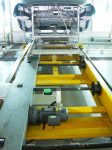
Application of Yike RFID in automobile coating production line
[ad_1]
The RFID products of Yike’s RF30 series are used in the body identification system of the spraying workshop of BAIC Zhuzhou Branch. It is used to coordinate production management and manufacturing, make the process more coordinated and smooth, and achieve the goal of improving production efficiency, saving energy and reducing consumption, and ultimately creating profits for the enterprise.

In this project, the RF30 series RFID read-write heads are arranged in the process section that needs to identify the car body information, such as the lanes of the machine transportation system, before entering the robot work area and the car body storage area, and use the information on the car body for process guidance. Because the RF30 series read-write head adopts ultra-high frequency design, the working frequency is 840~960MHz, which can carry out more data exchange in a shorter read and write cycle, which meets the needs of fast-paced and big data processing, compared with the current usual The high-frequency RFID system used has greatly improved the efficiency of reading and writing, speeding up the speed of vehicles entering and leaving the station, thereby providing a guarantee for the car factory to increase production capacity.
The AVI system (automatic vehicle identification) of this project selects Siemens 315-2PN/DP PLC as the main station of the system, and controls the reading and writing of on-site RFID through the DP network, and the optical fiber Ethernet exchanges reading and writing data with the upper computer, and DP-DP coupling The device exchanges data with the mechanized conveyor PLC and the robot PLC. The mechanized transportation PLC controls the selection of the transportation path based on the vehicle type information read by the RFID, and the robot PLC selects the vehicle type and color based on the data read by the RFID.RF30 series in the process of reading and writing control and data transmission of RFID systemRFIDThe adopted standard field bus interface realizes the easy networking with the main control PLC, perfectly implements the one-network control concept of field equipment, and improves the control efficiency.

The AVI system uses on-site RFID to write the body information into the code carrier, and guides the production of personnel and process equipment through the body information to complete the production tasks more efficiently and accurately. The system has the following characteristics:
● Write body information through the production queue;
● Read the body information to guide the production process;
● Hand-held device to modify the problematic body information in time;
● Clear the flow and transfer to the information in the code carrier of the next step.
At the same time, in response to the severe test of the high temperature of the coating process on the code carrier, the ELCO RF30 series has launched the high temperature code carrier RF30-TG-S300T, which can withstand high temperatures up to 250 ℃, ensuring that data will not be lost in a high temperature environment, and repeated high temperatures It can be used thousands of times in the environment, and it meets the high temperature resistance requirement of 220℃ in the coating process. In addition, the RF30 series IP67 modular design enables RFID to truly adapt to the industrial field environment and work stably and reliably for the complex and harsh working conditions such as coating process and industrial environment with dusty and strong electromagnetic interference.
After the project adopts the RF30 series of RFID as the core AVI system, a flexible production method of co-production of cars and commercial vehicles is realized. RFID tags are installed on the spreader and skid to branch off at the entrance of the paint shop and the car body. RFID readers are installed in the transfer stations of the process section, and the car body information is collected to the AVI server through the on-site PLC to realize the automatic deployment, precise positioning and quality monitoring of the car body of the entire paint shop, as well as the production cycle and car body information Real-time sharing of other information has greatly improved the automation and informatization level of the paint shop, and improved production efficiency.
[ad_2]




